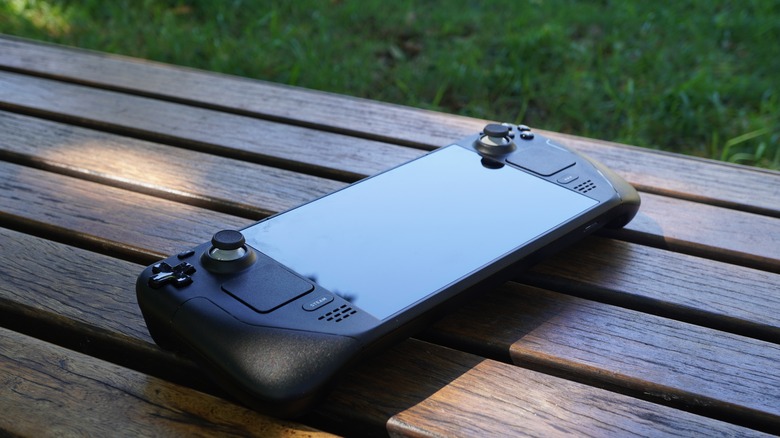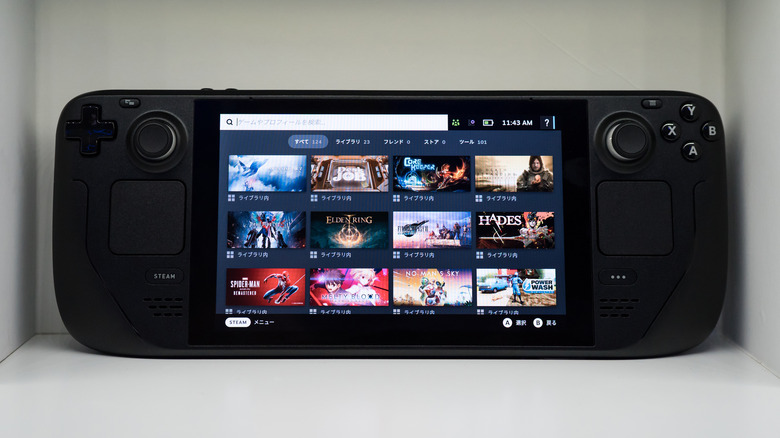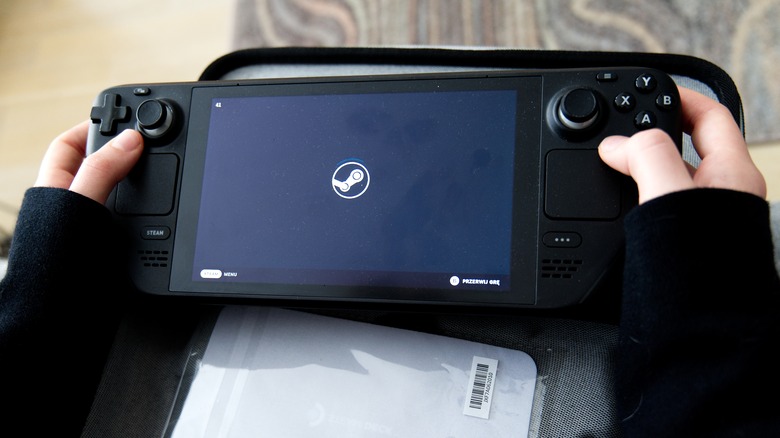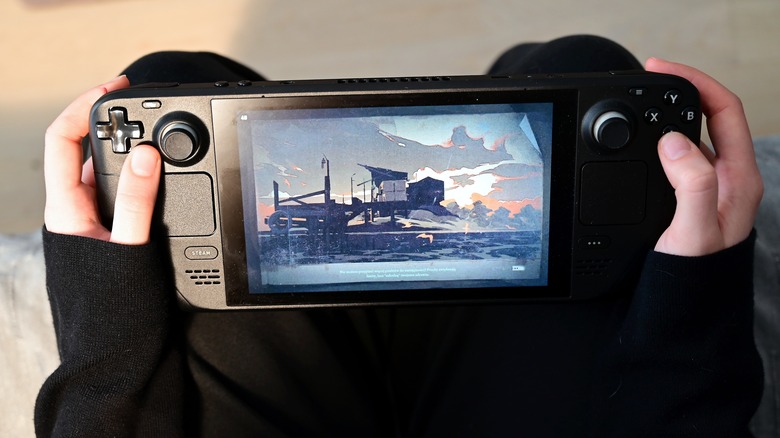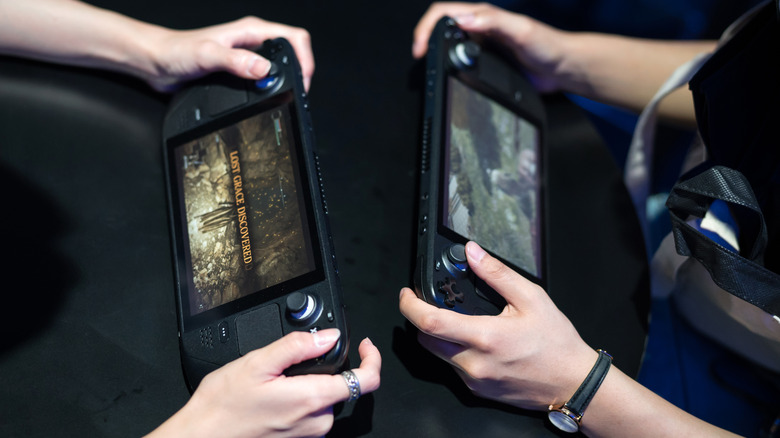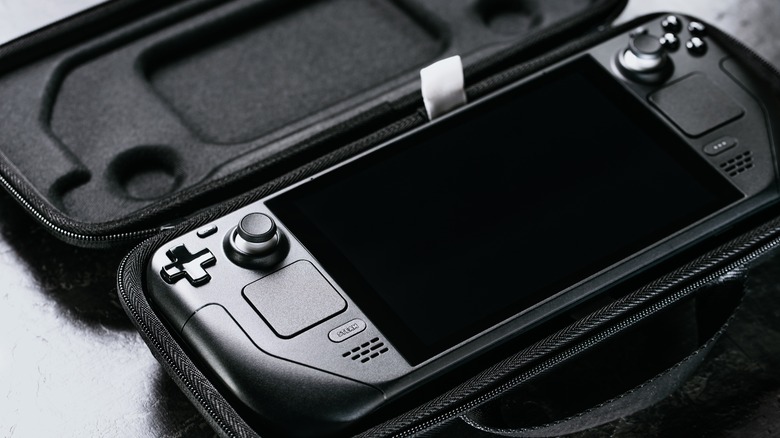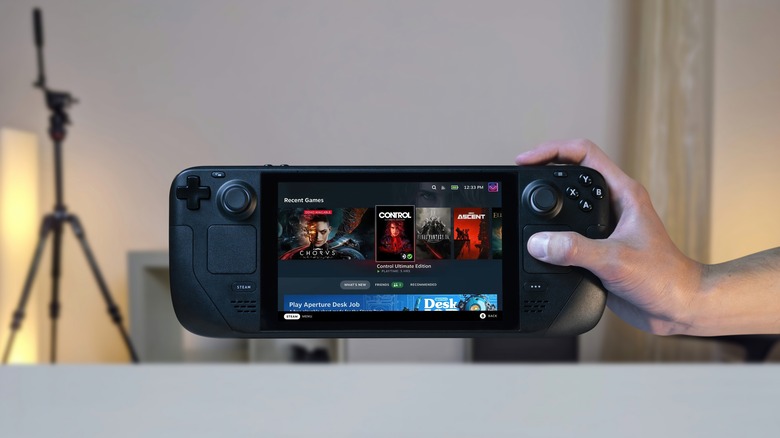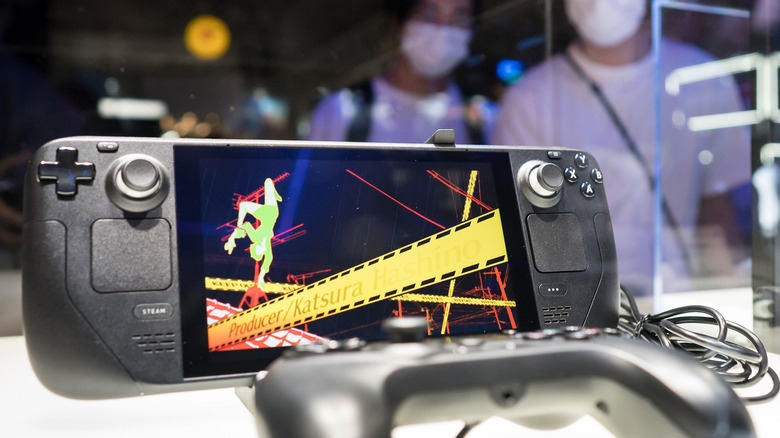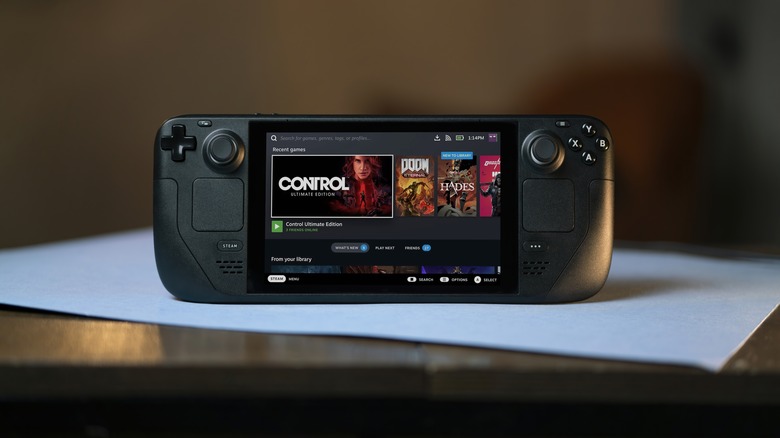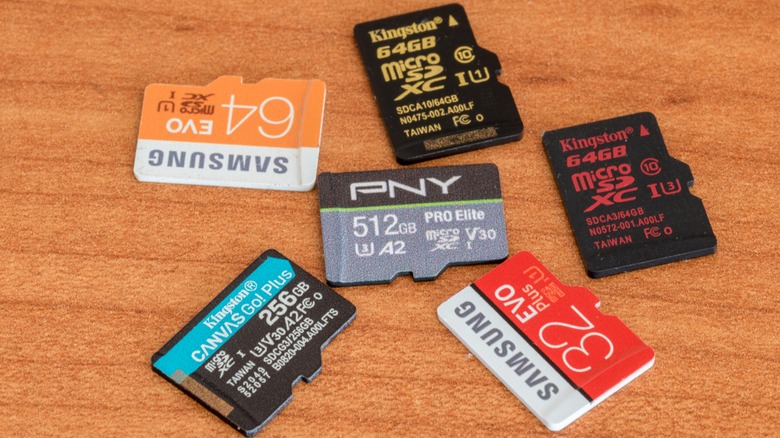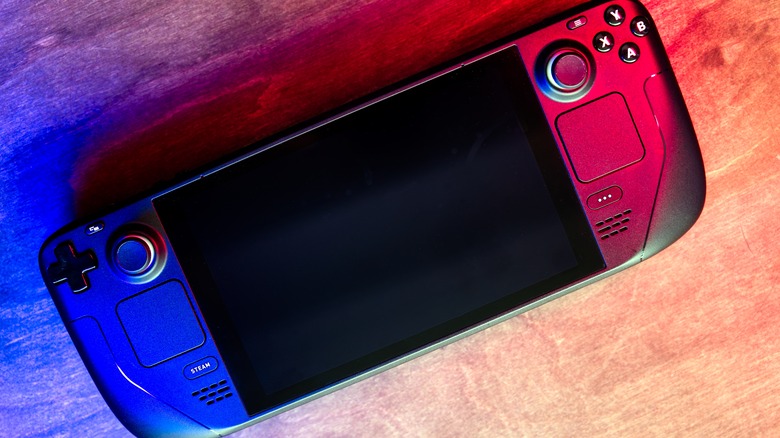5 Pros And 5 Cons Of Choosing The Steam Deck Over Other Consoles
Given that it's Valve's take on a portable gaming console, most consumers will probably immediately make connections between the Steam Deck and the Nintendo Switch. However, the Deck offers its own share of positives, allowing it to also be a viable alternative to Xbox and PlayStation consoles. In some cases, it can even stand up to PCs and laptops, making it an attractive choice for anyone interested in gaming — and even a few people who aren't.
Of course, being a portable device means the Deck had to make some sacrifices. These sacrifices can range from non-issues to make-or-break situations. Buyers should be aware of the pros and cons of getting a Steam Deck over another console, especially if they've never owned a separate gaming device before. While other consoles have their own benefits and downsides, the Steam Deck is unique in its hybrid PC/gaming functionality, and that uniqueness can impact a user's experience very differently from other devices.
The Steam Deck has an extensive game library
Thanks to the Deck's built-in compatibility with the Steam store, the only other device that can compete with its offering of games is a PC. The store offers tens of thousands of games with a quite few of them being completely free, putting other consoles to shame even when considering backward compatibility and multi-platform titles. Valve has also made an effort to make more games on the store compatible with the Deck's Linux operating system — even previously Windows-exclusive ones — expanding its library even further.
Since the Deck runs on Linux, it also has access to an even wider library of titles than what's officially available. On top of Linux-specific apps to run programs that would otherwise only work on Windows, the Deck's user community has provided plenty of tools for users who want to run classic console emulators on their Steam Deck. Using this method, players can fill their Steam Deck with an unfathomable number of old games to enjoy, to the point where it might be tough to play through all of them.
Just be aware that emulation doesn't always match the original experience. While most emulated titles released before 2007 will probably work just fine, users shouldn't expect anything newer to run without issues.
The controller has tons of features
Unlike most other consoles — including the Switch, which features detachable Joy-Cons — the Steam Deck's primary controller is built directly into the console itself. This has allowed Valve to pack it full of features that almost no other controller can match. One particular feature to note is the console's trackpads, which let players use mouse-like precision without needing to put down their controller. To reiterate, the Deck contains the functionality and game library of a PC, so this minor addition goes a long way in making all those games actually accessible.
Other aspects of the Deck are only found on controllers at higher price points, or from third-party manufacturers. Four buttons on the back of the Deck allow users to assign other functions, and even macros, providing far more control over certain games. There are also some very nice non-standard features, including an internal gyroscope and an extra menu button. Even if its built-in controller still leaves a few things to be desired, the Deck is compatible with just about every other controller out there, so players may still be able to use whatever they think is the best game controller of all time, even if it comes from another company.
As an added bonus, the Steam Deck can also automatically connect to your PC through Steam and function as a controller. It's not the most elegant integration out there, but it works well for games that recommend or require controller inputs.
The Steam Deck is very customizable
While every console can technically be customized with the right tools and setup, the Steam Deck is one of the few to allow it officially. Thanks to the Deck's user-friendly platform and active community, it's possible to modify the device in countless ways. All sorts of custom apps can enhance your Steam Deck experience, altering the its UI and boot animations, and tech-savvy users can even make those changes without any extra downloads. For those who want to make hardware modifications, Valve even has official guides that show how the Deck can be physically opened, allowing for parts-swapping and easier repairs.
If the limitations of Linux are too much to handle, Valve takes things one step further by letting Windows be installed onto the Deck, also providing Windows drivers and a future promise of dual-boot support. There are also recovery options for users who end up deleting a few too many important files on their Deck, or if the Deck itself just happens to fail at some point. This level of freedom isn't offered by Xbox, PlayStation, or Switch devices.
The Deck offers remarkable value
The price of the Steam Deck varies depending on the version, with the most expensive one being the $649 1TB OLED model. The cheapest non-discontinued option is the 256GB LCD model priced at $399 — around the same price of a digital-only PS5 and between the prices of the Xbox Series S and X. It's also far more expensive than the Switch, with the cheapest Lite model only being around $200. But the Deck's relatively high price point goes toward ensuring its games run smoothly.
Thanks to being a portable console, the Deck can handle modern games very efficiently at its default 1280 x 800 resolution. Slowdowns might start to show if the Deck is connected to high-resolution displays, but the smaller handheld screen size lets games keep their visual fidelity. For the most part, players can also expect games on the Deck to look and run better than on the Switch, especially poorly-made Switch ports like Mortal Kombat 1.
The Deck is far from an unstoppable powerhouse, and if requirements for the latest games are anything to go by, it might get left in the dust before long. But considering the vast library it already has access to, Valve's portable console is still able to run many intensive titles with impressive results. Depending on how powerful Nintendo's next offering might be, the Steam Deck could still be a decently tough competitor in the console market. Though, compared to a gaming PC, it's an absolute steal.
The Steam Deck travels very well
The Steam Deck is a device almost completely centered around portability, even more so than the Nintendo Switch. One of the best examples of this is the Deck's inclusion of trackpads and custom button shortcuts, allowing users to perform computer tasks without the need for peripherals like a mouse and keyboard. In games, players can alter frame rates and check battery performance immediately, allowing them to conserve energy and stretch their device's lifespan. The Deck also has other features not too dissimilar to the Switch, including a sleep mode accessed through the power button and built-in volume buttons.
The Steam Deck's focus on portability extends to what's included when customers purchase it. Even the cheapest options provide a hard carrying case to keep it secure and safe during travel. The most expensive version allows its own carrying case to have its liner removed, providing even more on-the-go storage options. The system also allows for hot-swapping microSD cards, meaning you can take more games on the go. When considering the software — and included case — the Deck is nearly unrivaled in its function as a portable console.
The Steam Deck is also relatively heavy and bulky
Though the Deck is a portable console, it can prove a bit unwieldy. It clocks in at over 1.4 pounds, almost double the weight of a Switch — even with Joy-Cons attached. This heft is made very apparent during gameplay, and that isn't exactly helped by the Deck's staggering size. Obviously, that size won't compare to an actual PlayStation 5 or Xbox Series X, but it's much heavier than either console's controller. Thanks to the built-in screen, it's among the largest first-party controllers ever, which could make it a bit difficult to use for players with smaller hands.
As a result of its size and weight, the Deck's portability can end up suffering. It's not going to fit in anyone's pocket, and younger users might end up having some difficulty holding it for very long. This issue is far from universal, but it should still be kept in mind when considering who's playing with the Deck in the first place.
The Steam Deck lacks additional accessories
Something buyers will discover when unpacking their Steam Deck is how few extra items it actually comes with. Outside of the carrying case and a USB-C charger, there are no additional items included with the Deck. No extra cables to connect to other peripherals, no stand to keep the Deck upright when not being held, and the only controller included is the one built into the device itself. Anyone who wants an official dock will find that it's only available as an extra purchase. Considering how non-lite Switch models are bundled with their own dock, this shows just how focused the Deck is on being a portable console rather than a hybrid device.
The Steam Deck's lack of included peripherals isn't too dissimilar to how other consoles are packaged, but the lack of any extra cables or accessories does make it seem sparse in comparison. To get the full functionality of the Deck, such as the ability to connect to other displays or USB-A drives, additional purchases must be made. This is also the case with the OLED Steam Deck — the upgraded model doesn't add more accessories than the removable carrying case liner at its highest price.
The hardware and software are unrefined
The Steam Deck is in a constant state of development, with software updates almost every week. Unfortunately, its unique operating system — when combined with its portable capabilities — ends up having trouble launching certain games. Numerous titles on Steam's store are marked as verified, playable, or unsupported. In other words, not every game will work on the Deck, namely VR titles and graphically intensive modern releases. Games that should work might also require some extra tinkering or an entirely different operating system, as they simply aren't designed to run outside of a Windows environment.
Even if the game runs just fine, eventually you'll also have another problem to contend with. The Steam Deck's battery life could be its biggest weakness, and more intensive games can really drain it fast, even if they're verified. Multiple users have experienced additional problems with Deck-verified games before — Death Stranding in particular has caused devices to crash altogether and then reboot. While the Deck's library is nearly unmatched, players shouldn't expect the greatest stability if they wish to push the console to its limits. It also doesn't hurt to stay near a power outlet when you can.
Digital storage space is an issue
Given how many games the Deck has access to, the greatest roadblock players will find toward actually playing them all is storage space. The Deck offers a 256GB model as its cheapest current option, but to get a full terabyte of storage, users will need to provide a whopping $649. The most expensive versions of the PS5 and Xbox Series consoles are around $150 cheaper than this version of the Deck, and they include 1TB storage as a baseline. The only way to expand this storage is through the use of microSD cards, which can end up being very expensive at higher capacities.
Compared to the Switch, it might seem like the Deck still wins out with the former's 32GB storage. But something important to note is how Switch titles are optimized in both texture capabilities and file size. Demanding games like DOOM Eternal take up far less space on Nintendo's console. The Steam Deck also relies on a shader cache to make games run more smoothly, causing its drive to fill up with these shaders while games are being played. This caching feature can be disabled, but doing so could lead to further performance issues.
Third-party game/software support is poor
The Deck's support for software may be lacking in some areas, but software needs to support the Deck as well. Unfortunately, it's not a priority for many developers. Steam is a platform where over 95% of users play on Windows, and many games are primarily designed with that in mind. Games that use certain anti-cheat programs may never support the Deck, and Windows-tailored updates may impact other games' performance.
Because of the online nature of digital games, updates can end up being pushed out to consumers whether they want them or not. This has even led to previously verified games becoming completely unplayable on Steam Deck, and needing extra patches to work again. That updates can worsen a game's functionality on the Deck rather than improve it is something that almost no other console has to worry about (generally). The only way to fully prevent this is to either keep the Steam Deck disconnected from the internet or to just hope game developers avoid releasing console-breaking updates.
This emphasizes the greatest difference between the Deck and other consoles. A PlayStation, Xbox, or Switch is much easier to jump in and play without worrying, and while the Deck provides a much more customizable experience, it comes with risks. Advanced users will be able to work around those risks — sometimes with exceptional ease — but casual players and first-time gamers might have an easier time with alternative options. Basically, there's a steeper learning curve.
